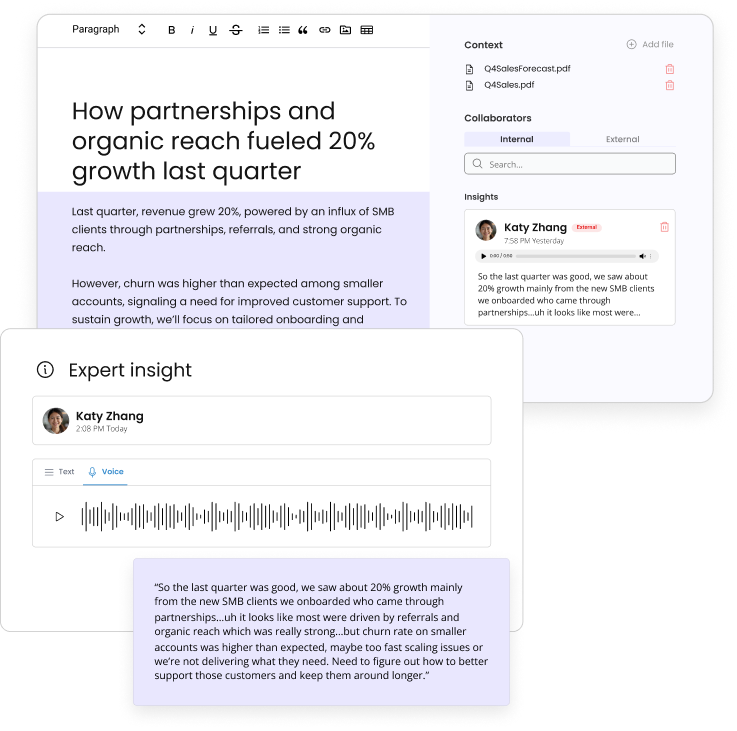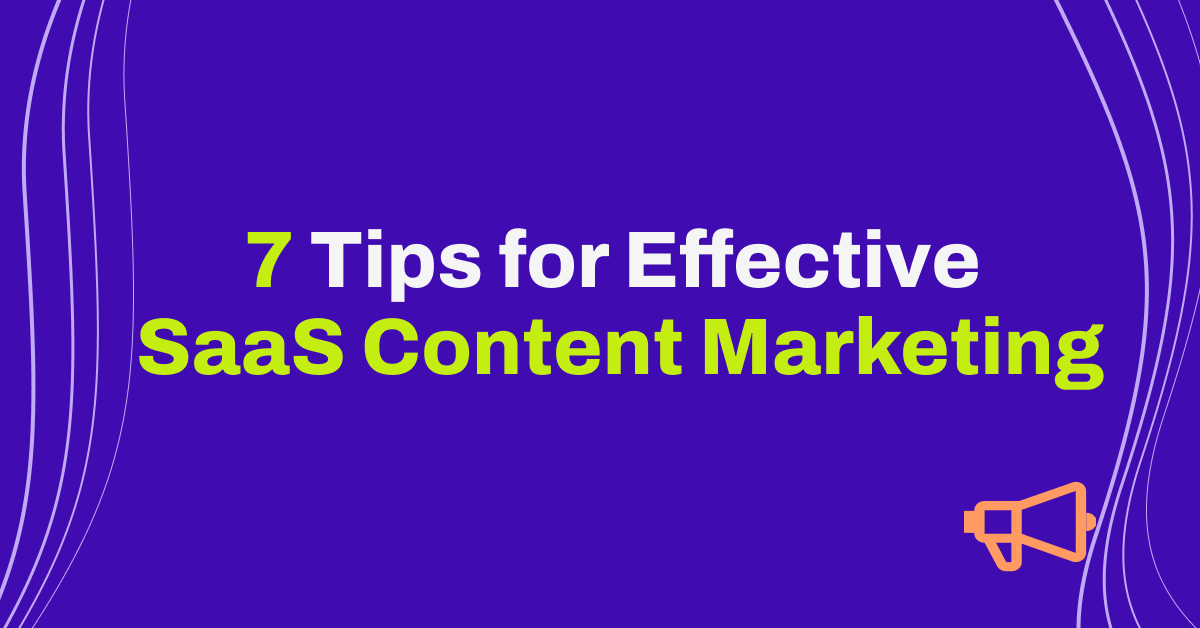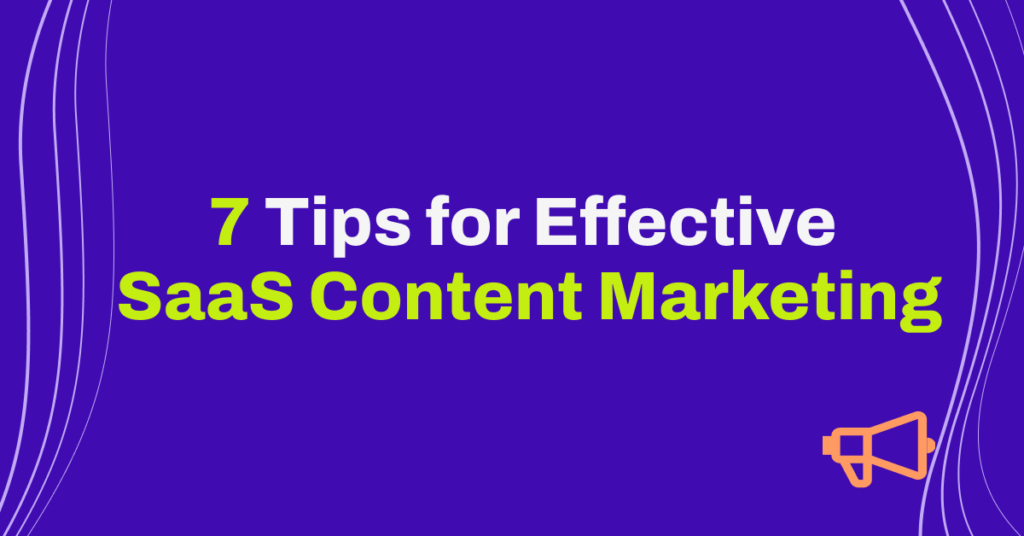Table of Contents

Authority scales when expertise comes first
Wordbrew helps teams collect expert insight before AI ever writes a word.
Built for expert-led, review-safe content
- Home
- »
- Content Marketing
- »
- 7 Secrets to Successful SaaS Content Marketing (Straight from Marketers Themselves)
-
Stacy Garrels
- 9 minutes read time
7 Secrets to Successful SaaS Content Marketing (Straight from Marketers Themselves)
- Home
- »
- Content Marketing
- »
- 7 Secrets to Successful SaaS Content Marketing (Straight from Marketers Themselves)
7 Secrets to Successful SaaS Content Marketing (Straight from Marketers Themselves)
Table of Contents

Let’s go on record: sporadic email blasts and fleeting social media trends just don’t cut it anymore. For most brands, especially those in the Software as a Service (SaaS) sector, these tactics fall short. The competition is fierce, and the technological landscape is evolving at break-neck speed.
The most successful SaaS companies out there are those that have cracked the code: content marketing, which boosts brand recognition, cultivates audience engagement, and catalyzes those all-important short- and long-term conversions. But how does one edge past the competition and carve a distinct space in the digital domain?
Let’s explore this together.
In this piece, we’re diving into SaaS content marketing: what it is, how it differs from traditional content marketing, and why it’s crucial to a SaaS company’s success. More than that, we’re sharing seven tips from top SaaS marketers to boost your content marketing strategy. Prepare to elevate your game and make waves in the SaaS sea with us.
TL;DR
- Regular content marketing won’t cut it in the world of SaaS—it must provide value, forge long-term customer relationships, and bring your product to life.
- Carefully consider where you want to distribute your content, and why. Popular content distribution channels for SaaS brands include blogs, newsletters, social media, discussion websites, videos, webinars, podcasts, and guest posts.
- Looking to try something new? Take it from the best in the business and experiment with SaaS marketing hacks, like leveraging user feedback, articulating your value proposition, creating alternative and comparison content, niching down, and more.
What is SaaS content marketing?
Content marketing is a digital marketing strategy through which brands create and share high-value content with their target audience, intending to attract and retain customers, secure better search engine rankings, and increase organic traffic to their website. Content marketing can be undertaken in-house or outsourced to a specialist content marketing agency.
However, writing content for SaaS comes with its own specific requirements. For example, SaaS content is all about…
Providing real value to potential customers
Instead of simply pushing your product, focus on building trust with content that educates your audience, speaks to their pain points, and convinces them that you have the solution.
Playing the long game
Unlike most industries, SaaS typically operates on a subscription model, meaning content has to span beyond paid ads and free trials—it must also reduce churn, secure subscription renewals, and nurture customer relationships.
Materializing the intangible
Customers cannot see or touch software, so there is extra pressure to breathe creative life into your product.

Which content channels do SaaS teams use?
Content creation is an integral aspect of modern marketing, but many fail to consider the importance of how to distribute that content—and where. After all, even the best content can flop if it’s not positioned to reach its audience, build brand awareness, boost engagement, and increase leads.
Getting your content in front of the right people at the right time and in the right place depends heavily on both your product and your audience, requiring some marketing research on your part.
That said, below are some good places to start.
Blogs
In the SaaS landscape, blogs are more than online ramblings: they’re powerhouses, locked and loaded with software-specific insights, responses to common user pain points, and expert advice. In turn, blog posts are exceptionally effective in attracting new customers, boosting website traffic, and ranking high on search engines. Pair this top-tier content with a strategic Pillar-Based Marketing approach, and you have a fully oiled machine driving more authority and organic traffic to your site.
Newsletters & Email
In the realm of digital marketing, newsletters and email campaigns are distinct but highly effective channels employed by SaaS teams. A newsletter, typically a regular communication sent to subscribers, aims to keep relationships alive and strengthen brand awareness by regularly sharing company updates, product information, and industry insights.
Meanwhile, email marketing campaigns are also a popular, more personalized choice. This is where companies target specific segments of their audience with messages addressed specifically to the reader to increase their engagement and drive conversions. For example, email campaigns might focus on pushing a free trial, offering product demos, promoting new features, or all of the above. It’s about reaching out and creating a one-on-one connection with each reader.
Social Media
Platforms like Twitter, LinkedIn, and Facebook are some of the most popular channels for SaaS content marketing teams because they help brands reach large audiences quickly and easily. This can mean anything from publishing engaging posts to establish your thought leadership to launching paid ads to boost brand awareness. According to Statista, over four billion people are using social media worldwide, so research where your target audience is hanging out and head there.
Social media platforms are also great spaces to create a dialogue with customers and prospects. Take Zendesk, known for quick, personalized responses to queries, feedback, and even occasional complaints. This active social media presence shows that the brand really practices what it preaches, showcasing the very principles of the software it promotes.
Discussion Websites
In addition to social media, many SaaS brands turn to discussion sites like Quora, Reddit, and Medium to engage with audiences and establish a presence. These platforms hone in on an albeit narrower set of customers and prospects, but they open up some goldmine opportunities. Answering questions on Quora, for example, helps inform people about your product straight “from the horse’s mouth”, establishing you as thoughtful experts that want to improve user experience. This, in turn, can win back old customers and attract new ones that are looking for solutions to specific problems.
Videos
Software is a tricky product to market because of its intangible nature—this is where demo videos and easy-to-follow how-tos come in. A great example of video content done well is HubSpot on YouTube, where they frequently upload product demos, tutorials, and educational videos about their software and general marketing strategies.
This channel is designed to not only guide current users through the functionalities of their platform but also to educate potential customers about the value their software could bring to their marketing efforts—and it’s working. HubSpot continues to have a strong brand presence, to bolster customer success, and attract new customers.
Webinars and Podcasts
These channels are all about thought leadership. Host webinars or podcasts on topics that are relevant to their audience, and you will be well on your way to building a loyal following and making your brand a known expert in your field. What’s more, you can also use these channels to engage with customers and prospects in a more personal way, answering their questions in real time during Q&A sessions.
Guest Posts
Finally, guest posts on other websites or industry publications are a great way for SaaS teams to reach new audiences and establish themselves as thought leaders in their field. By contributing high-quality content to other websites, companies can build their reputation and attract new customers who may not have heard of them otherwise.
7 stellar ideas to make your SaaS content marketing pop
Getting SaaS content marketing right requires time, effort, and a focused strategy. Here are seven tips from successful SaaS marketers to help you get your content marketing efforts off the ground:
- Leverage User Feedback
Justin Kerby, Something Great Marketing
Users—as well as their thoughts and feelings in response to your product—should lie at the heart of your content strategy. Your audience is an invaluable resource when deciding what content to create because they are happy to tell you what they struggle with, what they want to know more about, and where they see the most value in your product.
So, start a dialogue with them. Get to know their needs and create content that speaks directly to those. Forekast, for instance, uses forums like Reddit and Product Hunt to solicit feedback and gain insights on user experience, then uses that data to temperature-check customer satisfaction and identify opportunities for improvement. This, of course, leads to better and more focused content.

The core of successful content marketing lies in your ability to articulate your product’s unique value proposition. This means not just explaining what your product does, but how it can positively impact your users’ lives. Remember: your readers may not even have been looking for a solution to their problem, let alone a product like yours that solves it.
Prioritize identifying and highlighting the unique benefits of your product and the specific problems it solves—this will compel potential customers to choose your product over others. Vendry, for example, does this in a very authentic and accessible way that calls out to potential customers:

- Help Your Audience with Great Bottom of the Funnel Content
Josh Brown, Helpjuice
Placing yourself beside your big and powerful competitor is a super efficient way to get noticed while carving out your niche. You can do this by creating high-quality bottom-of-the-funnel content that helps high intent prospects make a decision quicker. .This includes:
“Alternative To” content, where you position your product as an alternative to another in the hope of capturing potential customers who are considering or already using a competitor product. For example, you might write a blog post for your project management SaaS product, entitled: “Top 10 Alternatives to Asana for Project Management,” and highlight how your product differs, perhaps in terms of features, pricing, or user experience.
“Comparison To” content, which is even more direct. The goal here is to help your potential customers make an informed decision by showing them how your product stacks up against others. For example, for that project management SaaS product, you might create a detailed comparison guide or an infographic that compares the pros and cons of your product versus Asana.
Helpjuice is a great example of how to utilize this strategy and demonstrate your competitive advantage, all through SEO magnets and competitive keywords, drawing in users searching for comparisons or alternatives in their product category.
With the dramatic rise of AI-driven content generation tools like ChatGPT and Bard, content production has surged, and standing out has become more challenging. Creating content that speaks to a smaller, specific audience can help you cut through the noise and find your audience efficiently.
To do this, though, you need a crystal clear understanding of the specific needs, interests, and concerns of your targeted audience segment, then you need to address all of the above directly in your content. Wizehive, for instance, creates blog posts that hone in on specific pain points to make their content relevant and valuable to their target audience.

- Put the ‘Service’ in SaaS
Shanique Brophy, Rocketseed
In an age where AI and automation are increasingly prevalent, maintaining and promoting a human touch in your service can be an exceptionally unique selling proposition. If this applies to your brand, be sure to highlight the quality of your customer service, product support, the availability of real people poised to help out, and your commitment to customer success.
Rocketseed, for example, makes it clear in its content that each customer will have a dedicated account manager who is available to assist at every stage. This provides a reassuring human touch that attracts and retains customers.
- Nurture and Follow Up with Leads
Vito Vishnepolsky, Martal Group
Continually engaging with your audience is a crucial aspect of SaaS content marketing. Always be on the lookout for opportunities to nurture leads with valuable, targeted content, build stronger relationships, and improve conversion rates.
A key tip here is maintaining communication with your prospects beyond their initial interaction with your brand, guiding them further along their buyer’s journey. Martal Group, for example, favors strategies like scheduling demos and sending reminder emails in an effort to keep prospects’ memory fresh with their product top-of-mind.
- Take to Twitter
Oliver Farmiloe, Matchable
Twitter in particular can be a powerful tool for finding and seizing PR opportunities. With journalists, influencers, and publications active on the platform, it’s an excellent place to reach out and share your story.
By creating shareable, newsworthy content, you can attract coverage, secure backlinks, and increase visibility—just like Matchable, which takes to Twitter to foster PR coverage with journalists and influencers. They share their stories, product updates, and industry insights on the platform to generate interest and attract traffic.
Let’s wrap up
Crafting the right content marketing strategy for your SaaS product goes beyond content creation: it requires understanding your audience, selecting the right distribution channels, leveraging user feedback, clearly articulating your value proposition, and more. In doing so, you can not only illuminate the unique benefits of your software but also build enduring customer relationships, drive conversions, and carve out a competitive edge in the bustling SaaS marketplace.
Remember, the key to a successful SaaS content marketing strategy isn’t just about being seen—it’s about being remembered and loved. Armed with these industry secrets, you are already halfway to giving your brand the boost it deserves.
Next stop? Taking that strategy and spreading the word! Wizeo is leading the content creation space in a post-AI world, so get in touch to talk authoritative, impactful content at scale today. Let’s make content your competitive advantage.
